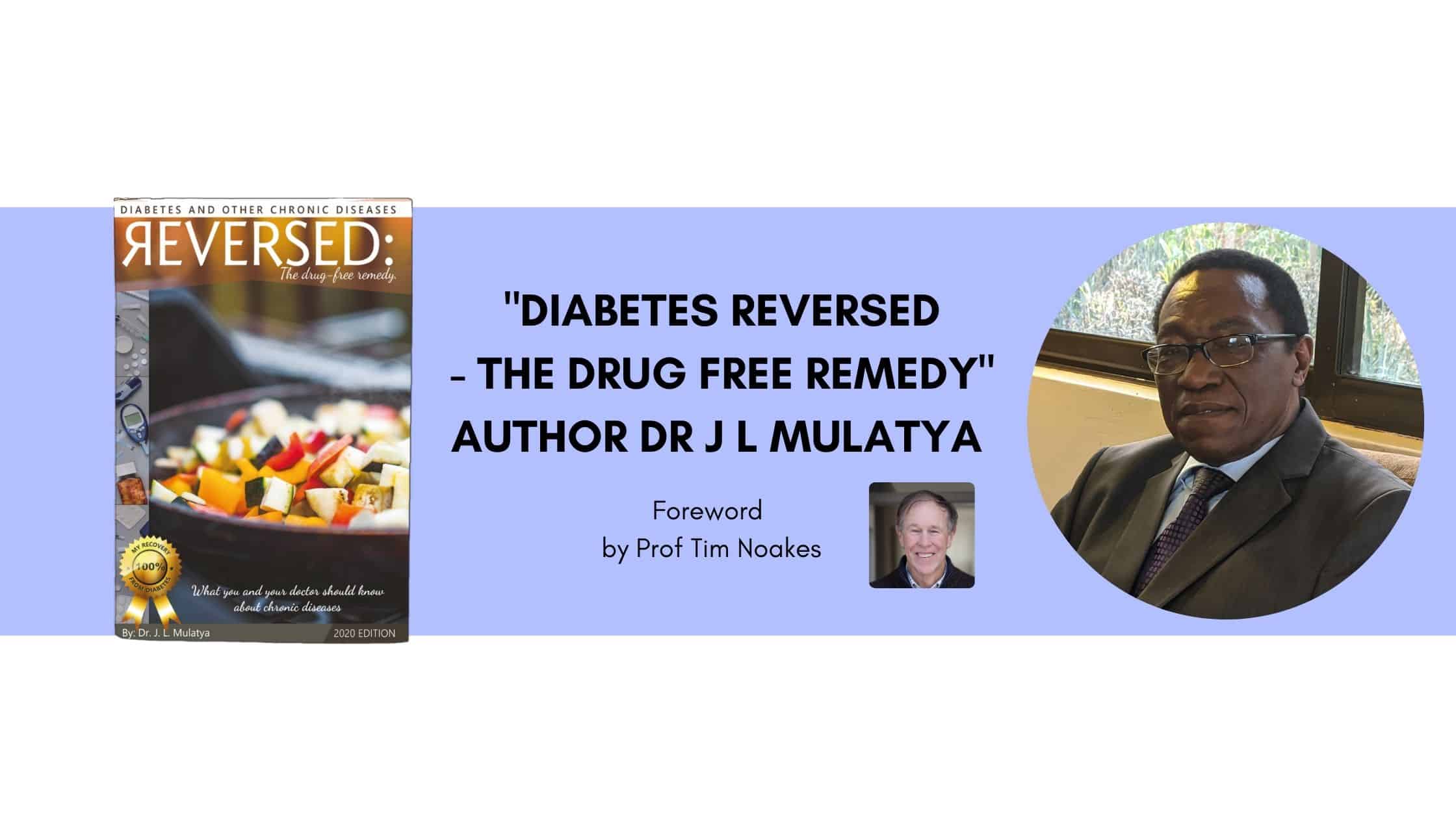
Dr. Jonah Lazarous Mulatya is C.E.O, consultant anaesthetist and General Practitioner at Mulatya Memorial Hospital, as well as an esteemed member of The Nutrition Network. His journey with a low carbohydrate high fat (LCHF) diet began in 2015 when he started reading widely on the application of ketogenic diet in the treatment of diabetes. He has launched the Low Carb High Fat (LCHF) diabetic clinic at Mulatya Memorial Hospital, which has been highly successful. He has recently gone on to publish his book “Diabetes Reversed: The drug-free remedy”, in which Prof Tim Noakes has proudly written the foreward.
“Diabetes Reversed: The drug-free remedy” – Foreward by Prof Tim Noakes
“It takes great courage to change one’s mind. Not least to question a conviction that one has trusted and religiously followed for all of one’s professional career. And on which one has based the management of patients who have placed their faith in you, the doctor, in the belief that you will always practice, and deliver, what is in their best interests.
But there may well come that moment when that doctor is forced to face an uncomfortable truth. When the trusted expert becomes aware, painfully at first, that some of what he or she professes, is not just plainly wrong. But also harmful. That the trust the patients have placed in their healer, is misplaced. And it is then that the great doctors, the very best, instinctively know that whatever the cost to their pride and ego, they must acknowledge their error. They must reject much of what they formerly believed and, instead, embrace a novel truth.
Dr J.L. Mulatya is one of those great doctors who, when faced with that moment of truth, did not falter. Instead he swallowed his pride and chose the path of humility and righteousness.
Dr Mulatya relates that he was born into a well-to-do Kenyan family, the son of a Colonial Chief. He grew up eating the healthy and nutritious Kenyan diet of cooked beans, maize, ugali and traditional green vegetables, supplemented with occasional beef, goat, mutton and cows’ milk. During the Festive Season, boiled eggs, chicken stew and chapatti were added delicacies.
Large herds of cattle grazed on the lush grasslands and food was plentiful. Diseases were uncommon with the exception of transient fevers as well as measles, whooping cough and polio, before vaccination became more widespread. Supportive medical care was provided by shrewd traditional healers, whose abilities are generally unappreciated by the paternalistic attitude of conventional Western medicine.
But Dr Mulatya tells how all that has changed in just one generation. The traditional healthy Kenyan diet of locally-grown foods has been replaced by the foods of the colonists; what Dr Weston Price called the “displacing foods of modern commerce” (1). With devastating consequences. And Dr Mulatya himself has been one of its casualties.
So it was that in in 2007 at age 52 years, Dr Mulatya was faced with the reality that he had developed type 2 diabetes mellitus; a disease which his training would have taught him is progressive, irreversible and leads to an early death from any of a number of different, devastating complications. Like blindness, kidney failure, heart disease, stroke and lower limb gangrene requiring amputation.
For the first year after his diagnosis Dr Mulatya followed the standard medical advice. He religiously took his prescribed medications even though they caused him significant side-effects. He followed a low-fat “heart-healthy” diet with limited meat and eggs and in which sugar and sugary drinks were forbidden. But there was no restriction on sweet and sugary fruits; or on carbohydrate-rich vegetables, millet, sorghum, ugali, beans or peas.
But after his mother died of the complications of type 2 diabetes, Dr Mulatya was jolted out of his complacency. He realized that if he was to avoid the same fate, he would need to learn more about his disease. He appreciated, dimly at first, that the most effective way for the doctor to learn about any disease is for the doctor to first develop that disease. And to learn how to live with it. But it would take time for the critically important lessons of this particular disease to be learned.
By 2012, five years after his diabetes diagnosis, Dr Mulatya had developed the first tell-tale signs of poorly controlled diabetes – numbness in his lower limbs indicating the development of diabetic peripheral neuropathy. But the only cure he could find online involved a variety of herbal remedies, none of which worked.
The initial breakthrough came in 2015 when he encountered the TEDx talk by Dr Sarah Hallberg entitled: Reversing Type 2 Diabetes Starts by Ignoring The Guidelines. That presentation attests to the miracle of social media. Already it has been viewed by more than 3 million people. It was the turning point. It opened the doctor’s eyes to a world of medicine that he did not know even exists.
But still he was not yet ready to commit fully to Dr Hallberg’s challenge.So a year later despite using even more medications, his blood glucose control had become yet more erratic. Although he was following the “healthy” lifestyle including eating the diet prescribed by a Nutritionist according to the Kenya Diabetes Association’s Nutrition guidelines; he was exercising regularly and avoiding sugar and alcohol. Yet he continued to carry excess weight.
His moment of truth came in November 2017 when he discovered the Banting low-carbohydrate high-fat diet. Combined with intermittent fasting, he finally began this new method of eating, fully a decade after he had first been diagnosed as a type 2 diabetic.
At first it was not easy as he had to cope with an overpowering craving for carbohydrates manifested as a range of bodily symptoms. But the positive outcome was that, within days, his severely elevated blood glucose concentrations had fallen dramatically to within the low-normal range. He began removing first one, then two, and ultimately all three of his diabetes medication. Within six weeks, his weight was also within the normal range. As he writes: “the feet numbness…was decreasing, my mood and sleep patterns had greatly improved, the brain frog disappeared; I was strong and energetic the way I used to feel twenty years prior. My vision improved, in less than four months my HbA1c dropped from 9.8 to 5.5%. YES, I HAD REVERSED DIABETES!”.
In short Dr Mulyata had experienced a miracle. A miracle that his profession cannot acknowledge because it conflicts so absolutely with the current medical model of type 2 diabetes as an incurable, progressively fatal condition. The medical profession which, in its ignorance and willful blindness (3) prefers rather to promote an incorrect therapeutic model, using pharmaceutical drugs to “treat” a condition that, as Dr Mulyata experience shows, is a behavioral disease caused purely by inappropriate food choices.
This book is so important because it uses Dr Mulyata’s personal but anecdotal experiences to introduce the hard science that explains why his personal miracle is not really a miracle at all. It is a miracle only to those who refuse to engage with that hard-won evidence. It is certainly not a miracle to those who understand that it is predicted by the wealth of the science that he has carefully presented in the pages of this book. Dr Mulyata shows concisely that, thanks to the scientific work of Dr Hallberg and her colleagues (2) and many others, we now know that type 2 diabetes is eminently “reversible” in the vast majority of sufferers. But only if they understand that the choice is there’s. Eat properly and reverse the disease. It really is that simple.
There is a reason why Dr Mulyata has been chosen to traverse this difficult and treacherous path. Because what he learned and the message he wishes to present, is so very, very important for the continent of Africa.
The peoples of our continent have struggled for centuries with the ravages of infectious diseases. Now increasingly we are suffering under the added burden of what are incorrectly labelled “chronic diseases of lifestyle”. Like obesity, high blood pressure, metabolic syndrome and diabetes.
But these are NOT diseases of lifestyle; they ARE diseases of nutrition as Dr Mulyata’s experience clearly shows. And if all are diseases of nutrition then their prevention and cure must be a nutritional one – exactly as Dr Mulyata’s experience proves to be the case.
But the only way that we can ever promote a nutritional solution for these nutritional diseases, is if we radically alter the way medicine is taught on our continent. We need to return to the eating patterns we once followed when these nutritional diseases had yet be encountered by African peoples.
This book promises a new start.
It must be in every medical school library across the continent; it needs to be in every high school library from Cape to Cairo; from the shores of the Atlantic Ocean in the West to the Indian Ocean in the East.
Dr Mulyata’s courage is his gift to us.
We must not waste it.”
Emeritus Professor Timothy Noakes OMS, MBChB, MD, DSc, PhD (hc), FACSM, (hc) FFSEM UK, (hc) FFSEM (Ire)
References:
- Price W. Nutrition and Physical Degeneration: A comparison of Primitive and Modern Diets and Their Effects. Benediction Classics, United Kingdom. 2010.
- Hallberg SJ, McKenzie AL, Williams PT, et al. Effectiveness and safety of a novel care model for the management of type 2 diabetes at 1 year: An open-label, non-randomized, controlled study. Diab Ther 2018;9:583–612.
- Heffernan M. Wilful Blindness. Why we ignore the obvious at our peril. Bensalem PA, USA. 2009
